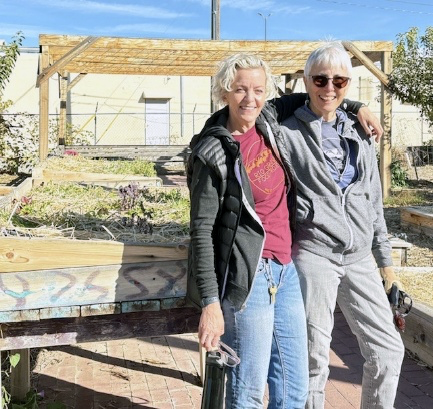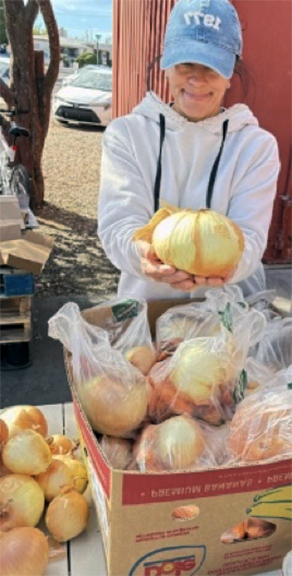

All RGFP services provide insight into the hidden face of hunger. The commonly held perception — that people want to live on the dole — is not accurate. “Our guests live in all sorts of situations. There are families moving in together as the economy gets tighter; there are furloughed federal workers; there are parents working three jobs to make ends meet. The list is endless,” according to Jann Kindel, RGFP’s Development Associate. RGFP was started in 1989 by the Rio Grande Presbyterian Church. RGFP has since become its own separate non-profit 501(c) organization and operates out of the back of the church and continues to share communal space with plans to expand in the future.
Offering more comprehensive services than a food pantry, RGFP’s mission is to “alleviate hunger and cultivate long-term food security within our communities,” according to their website, More Than Just Food – Rio Grande Food Project.
That’s a tall order in these days of growing food insecurity as the administration continues to drastically cut funding for food and medical assistance. We in New Mexico are grateful to our state leaders who are trying to bridge that gap with state funds. But the need continues to grow as political uncertainty doggedly continues.
What Services Does RGFP Provide?
“We call our program a three-pronged Rubik’s Cube” explained Jann. “It includes a bustling food pantry, our urban garden, and a community hub to get connected with community services and resources to maximize household incomes. The program also offers a variety of classes from financial literacy to food nutrition to healthy cooking, and a whole lot more.”
- The Food Pantry provides free groceries to over 1,300+ people every week; distribution is held three days a week, two hours a day from 9:00am-11:00am every Wednesday, Friday, and Saturday The lines wrap around the church well before the doors open. Minimal registration information is taken; no documentation is required. Each guest gets a box of pre-selected non-perishable nutritious food, plus any available meat and dairy, bread and produce.
- The Community Hub brings together a myriad of service partners and resources offering bill assistance in partnership with the PNM Good Neighbor Fund Program, and the Albuquerque Bernalillo County Water Utility Authority’s Low-Income Household Water Assistance Program (LIHWAP). Partners offer education such as financial literacy and cooking and nutrition classes throughout the year.
- The Urban Garden teaches people how to grow food in a small place. “It’s not only a handout; it’s a leg up,” Jann explained. Last year, they harvested 1,100+lbs of fresh fruit and vegetables. RGFP partners with Albuquerque Master Gardeners to help direct the program. RGFP guests and volunteers support it. All the fresh food gets harvested, weighed, and goes straight to guests through the food pantry. Food pantry produce that is past prime and most garden waste is composted to create a closed-loop system, where spoiled produce, garden plants, and non-invasive weeds are turned into rich, free compost for our garden beds. The garden remains unfenced to provide a welcoming atmosphere for community but is vulnerable to vandalism which is a continuing matter of balancing services and risk.
How Can WSD Members Help? The main ways we can help are by donating and giving our time, as well as by spreading the word about the good work that RGFP does.
- Donations: RGFP receives funding from grantors, private individuals, churches, corporations and organizations, and federal funding. As federal funding diminishes, the reliance on private donations increases.
- Donations support food distribution, community services access, and education. They allow staff to buy food in bulk, which helps the RGFP to be more efficient. RGFP has been growing beyond its current space for years and is moving toward its vision of building a guest-choice grocery store on the empty lot it now owns adjacent to the pantry and garden space.
- The federal Farm to Food Bank program that helps local farmers provide nutritious food for the RGFP guests has been suspended and concerns RGFP since healthy food distribution is a major focus. Unrestricted donations allow RGFP to put the money where it is needed most.
- Volunteers: Luckily, the small fingerprint of RGFP can thrive because of their dedicated, long-term volunteers. Their “just in time” food program requires food to be moved in and out, quickly and efficiently. But the ongoing need for volunteers is critical to their existence:
- Although RGFP has many dedicated, long-time volunteers, there is a need to supplement its core volunteers for intake on food distribution days. Intake volunteers register guests and are cross-trained. Options exist for long-term volunteer commitments and those who can fill more short-term roles.
- Food boxes and additional items are carried via shopping carts for many RGFP guests; RGFP is always in need of carry-out volunteers on food distribution days.
- Food drives are conducted throughout the year and volunteers can assist with food barrel/box drop-off and pick-up.
- RGFP hosts two annual fundraisers: a Garden Party in June and the Hike to End Hunger, their largest annual fundraiser that combines a healthy walk with a good cause, in October. Each event needs people to help with pre-event logistics, and set-up and teardown on the day of. This is perfect for a group to support.
- Help in the urban garden through the growing season (March-November) and learn alongside Master Gardeners – no green thumb needed!
- Volunteers are always needed for short-term projects, from reorganizing the office to lending a helping hand where it’s needed.

